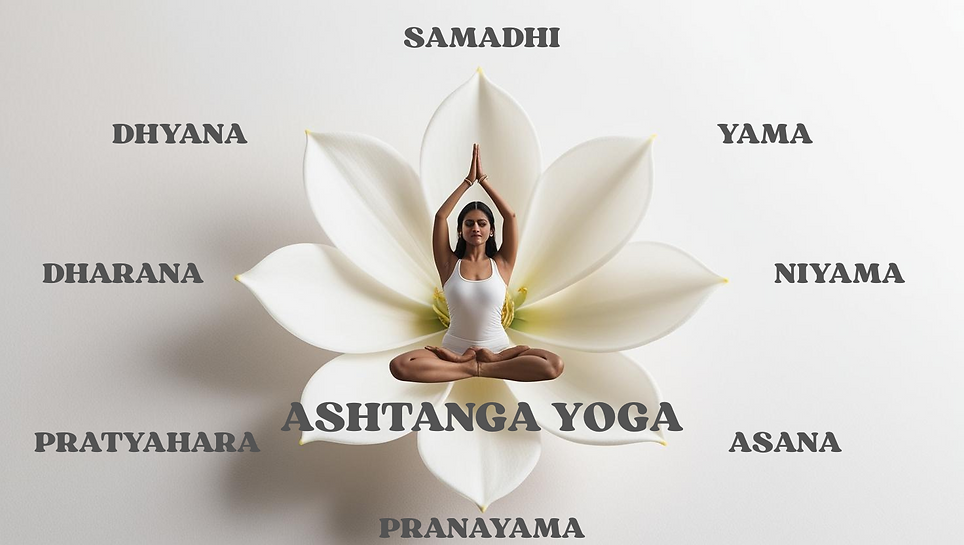Ashtanga Yoga Bern: Authentic Practice &
Yoga Teacher Training Switzerland

Ashtanga Yoga Bern: Authentic Practice & Yoga Teacher Training Switzerland
Yogveda Yoga, developed by Shahid Khan, offers an authentic and modern approach to classical Ashtanga Yoga, blending the timeless wisdom of Patanjali’s Yoga Sutras with contemporary needs. Based in Bern, Yogveda Yoga provides a transformative practice that adheres strictly to the eight limbs of Ashtanga Yoga, enriched by Shahid Khan’s deep expertise in anatomy, physiology, and yoga philosophy. Join us to experience the depth of Ashtanga Yoga at Yogveda Yoga and deepen your practice through our Yoga Teacher Training in Bern and Switzerland.
What is Classical Ashtanga Yoga?
Ashtanga Yoga, as outlined in Patanjali’s Yoga Sutras, translates to the "eight-limbed path" and encompasses Yama (ethical principles), Niyama (self-discipline), Asana (postures), Pranayama (breath control), Pratyahara (withdrawal of senses), Dharana (concentration), Dhyana (meditation), and Samadhi (spiritual union). Unlike modern Ashtanga Vinyasa Yoga, known for its dynamic sequence of movements, Yogveda Yoga focuses on the philosophical and practical aspects of the eight limbs to foster a holistic transformation of body, mind, and spirit.
How Yogveda Yoga Embodies Ashtanga Yoga Principles
Yogveda Yoga adheres to Patanjali’s traditional teachings, integrating them into a structured practice suitable for both beginners and advanced practitioners. Shahid Khan’s expertise ensures that Yogveda Yoga offers an authentic and profound Ashtanga Yoga experience:
-
Yama and Niyama (Ethical Disciplines):
-
Yogveda Yoga embodies Ahimsa (non-violence) by encouraging practitioners to listen to their bodies and avoid strain.
-
It promotes Santosha (contentment) by fostering gratitude for the body’s abilities and progress.
-
The method emphasizes Tapas (discipline) through its structured 48-week program, supporting consistent practice and self-improvement.
-
-
Asana (Postures):
-
Yogveda Yoga prioritizes geometric precision and alignment, aligning with Patanjali’s definition of Asana as "sthira-sukham asanam" (steady and comfortable posture).
-
The patented Yogveda Yoga Mat ensures each posture is performed with accuracy, correcting misalignments and enhancing the transformative power of asanas.
-
The four-week cycle (forward bends, backbends, twists, standing poses) systematically prepares the body for advanced postures, ensuring safety and effectiveness.
-
-
Pranayama (Breath Control):
-
Yogveda Yoga integrates breath awareness into every posture, helping practitioners connect with their prana (life force) and deepen their practice.
-
The focus on chest-opening postures improves lung capacity and respiratory health, supporting pranayama practice.
-
-
Pratyahara (Withdrawal of Senses):
-
The method’s emphasis on mindfulness and internal awareness helps practitioners turn their attention inward, preparing them for meditation.
-
-
Dharana, Dhyana, and Samadhi (Concentration, Meditation, Union):
-
Inversion practices like headstands, shoulder stands, and handstands enhance physical health while improving mental focus and spiritual connection.
-
The systematic 48-week program builds mental resilience and spiritual harmony, guiding practitioners toward the ultimate goal of yoga: union with the divine (Samadhi).
-
Why Yogveda Yoga is More Authentic
Yogveda Yoga stands out by strictly adhering to Patanjali’s eight-limbed path, distinguishing itself from modern yoga styles that often focus solely on physical fitness. Under Shahid Khan’s guidance, an expert in classical yoga philosophy and modern anatomy, Yogveda Yoga offers a deeply authentic practice that captures the essence of Ashtanga Yoga:
-
Fidelity to Tradition: Unlike many modern styles, Yogveda Yoga integrates all eight limbs of Ashtanga Yoga, ensuring a holistic transformation.
-
Shahid Khan’s Expertise: With decades of experience in yoga philosophy, anatomy, and biomechanics, Shahid Khan brings a profound understanding to the practice, making Yogveda Yoga uniquely authentic.
-
Systematic Approach: The 48-week program is scientifically designed to address every part of the body, from the feet to the neck, ensuring balanced and safe progress.
Unique Benefits of Yogveda Yoga
-
Scientific Precision: The patented Yogveda Yoga Mat ensures precise alignment, maximizing the benefits of each posture and minimizing injury risks.
-
Modern Relevance: Yogveda Yoga addresses modern challenges like poor posture, stress, and sedentary lifestyles, offering therapeutic benefits for all levels.
-
Holistic Transformation: Beyond physical health, Yogveda Yoga fosters mental clarity, emotional balance, and spiritual growth.
-
Inversion Practice: Headstands, shoulder stands, and handstands strengthen the body, improve focus, boost immunity, and elevate mood.
Ashtanga Yoga in Yoga Teacher Training
Ready to not only practice but also teach the authentic principles of Ashtanga Yoga? Our Yoga Teacher Training in Bern and Switzerland at Yogveda Yoga provides the opportunity to master the eight limbs of Ashtanga Yoga under Shahid Khan’s guidance. Learn how to integrate these timeless teachings into your practice and teaching, empowering your students on their journey. Learn more about Yoga and Vedic philosophies with Shahid Khan at Yogveda Yoga in the workshops and Yoga Teacher Trainings.
Conclusion
Yogveda Yoga in Bern is more than a yoga practice—it’s a transformative journey that combines the authentic wisdom of classical Ashtanga Yoga with modern precision and Shahid Khan’s expertise. Whether you’re new to yoga or a seasoned practitioner, Yogveda Yoga offers the tools and guidance to achieve physical health, mental clarity, and spiritual harmony. Book your trial session for 30 CHF and experience authentic Ashtanga Yoga at Yogveda Yoga in Bern.
